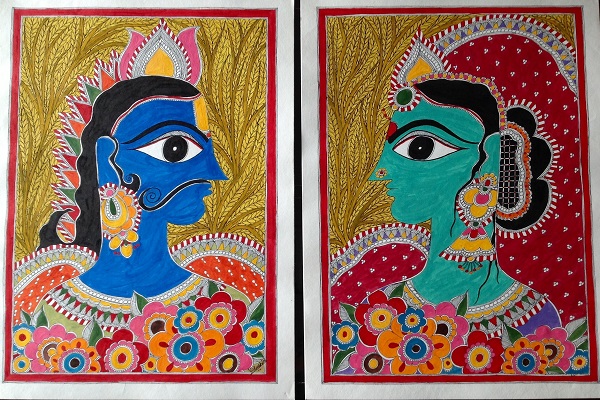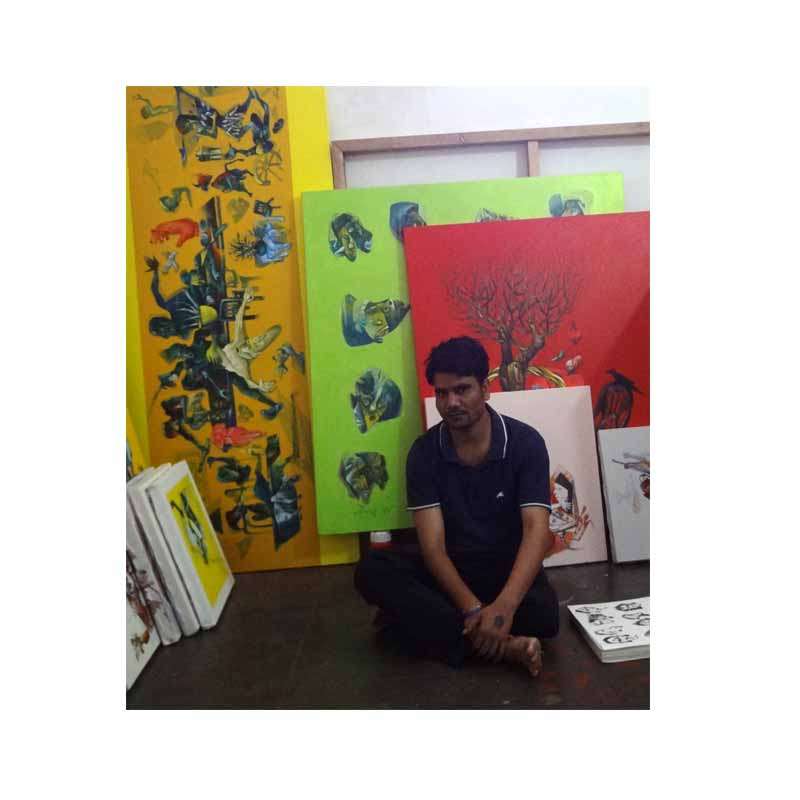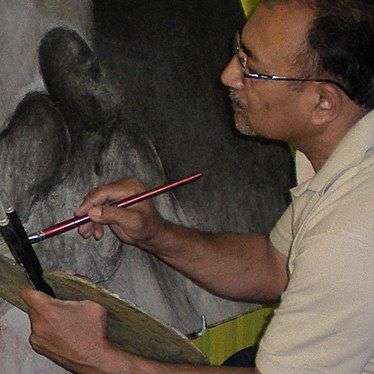
Welcome to a journey into the vibrant and culturally rich world of traditional Indian art! With a history that spans over five millennia, Indian art is a fascinating and diverse subject that has evolved over time, reflecting the country's complex social, political, and religious landscape.
Traditional Indian art encompasses a wide range of art forms that have been practiced in the Indian subcontinent for centuries. From intricate paintings and sculptures to colourful textiles and pottery, these art forms are steeped in tradition, culture, and spirituality.
One of the defining characteristics of Indian art is its bold and vivid use of colour. Colors play a crucial role in traditional Indian art, conveying a range of emotions, ideas, and cultural themes. In Indian art, colour is not just a visual element but a powerful symbol that reflects the spiritual and cultural values of the subcontinent.
Through this post, we will delve into the significance of colour in traditional Indian art, exploring its use across different art forms and how it is used to convey a variety of meanings and messages. We will also explore the spiritual and cultural significance of colour in Indian art and how it reflects the broader cultural and spiritual traditions of the subcontinent. So, let's dive into the world of traditional Indian art and explore the role of colour in this rich and vibrant artistic tradition!
Significance of Colour in Hindu Art
Color plays a significant role in Hindu art, which is deeply influenced by Hinduism, one of the oldest religions in the world. In Hinduism, colours are seen as symbols of the divine and are used to represent different gods, goddesses, and spiritual concepts.
Each colour has its own symbolic meaning in Hindu art. For instance, red represents purity, sensuality, and power, while yellow symbolizes knowledge, learning, and wisdom. Blue represents the infinite and is associated with the god Vishnu, while green represents life and happiness and is associated with the goddess Parvati.
The use of colour in Hindu art can be seen in various art forms, including paintings, sculptures, and textiles. For example, in Indian miniature paintings, artists use bright and bold colours to depict mythological scenes and stories, often highlighting certain colours to convey specific meanings. Similarly, in Hindu sculptures, colours are used to bring out the beauty and grace of the deities, with each colour serving a specific purpose.
One of the most significant examples of the use of colour in Hindu art is the Holi festival, also known as the festival of colours. This annual festival is celebrated across India and marks the victory of good over evil. During the festival, people throw coloured powder and water at each other, creating a colourful and vibrant atmosphere that reflects the joy and happiness of the occasion.
Overall, the use of colour in Hindu art is deeply rooted in spiritual and cultural traditions, and it plays a crucial role in conveying meaning and symbolism in various art forms. Through colour, artists are able to evoke emotions, tell stories, and celebrate the divine, making Hindu art a rich and visually stunning tradition.
Significance of Colour in Buddhist Art
Buddhist art is a rich and diverse tradition that is found in various parts of Asia, including India, Tibet, China, Japan, and Southeast Asia. The use of colour is an essential part of Buddhist art, and it is used to convey spiritual and philosophical concepts.
In Buddhist art, colours are often associated with the different elements, including earth, water, fire, air, and space. Each colour is also linked to specific Buddhist deities, representing their attributes and qualities. For instance, red is associated with the life force and is linked to Amitabha, the Buddha of infinite light. Blue is linked to the element of water and is associated with Akshobhya, the Buddha of the East.
The use of colour in Buddhist art can be seen in a variety of forms, including paintings, sculptures, and mandalas. For example, in Tibetan Buddhist thangka paintings, artists use vibrant colours to depict the Buddha, bodhisattvas, and other spiritual figures, often with intricate details and symbolic elements.
Another example of the use of colour in Buddhist art is seen in the mandalas, which are intricate, circular designs that represent the universe. Mandalas are often used in meditation and are believed to have a transformative effect on the mind. Mandalas are created using specific colours, with each colour representing a different element or deity. For instance, green is associated with the element of air and is linked to the Buddha of the North.
Overall, the use of colour in Buddhist art is a reflection of the broader spiritual and philosophical concepts of Buddhism, with each colour representing a different aspect of the divine. Through colour, artists are able to create stunning and intricate works of art that convey complex ideas and inspire meditation and contemplation.
Significance of Colour in Mughal Art
Mughal art is a unique and distinctive style that emerged in India during the reign of the Mughal dynasty in the 16th and 17th centuries. The use of colour is an essential element of Mughal art, which is characterized by its intricate details, vibrant colours, and refined aesthetic.
In Mughal art, colours are used to create a sense of depth and perspective, with lighter colours used to create a sense of distance and darker colours used to create a sense of foreground. Colors are also used to create a sense of mood and atmosphere, with warm colours used to create a sense of intimacy and cool colours used to create a sense of distance.
The use of colour in Mughal art is also symbolic, with each colour representing a particular emotion or idea. For example, red is associated with passion and power, while blue is associated with peace and tranquility. Gold and silver are often used to represent wealth and status, while green is associated with life and nature.
Examples of how colours are used in Mughal art can be seen in various art forms, including paintings, textiles, and architecture. For example, in Mughal paintings, artists use rich and vibrant colours to depict scenes from court life, hunting, and religious subjects. The colours used in the paintings are often used to convey the emotions and ideas associated with the subject.
Similarly, in Mughal textiles, artists use a range of colours and intricate designs to create stunning patterns and motifs, often inspired by nature. Mughal architecture is also characterized by the use of vibrant colours, with intricate designs and patterns adorning the walls and ceilings of buildings.
Overall, the use of colour in Mughal art is a reflection of the Mughal empire's rich cultural and artistic traditions, with each colour representing a particular emotion or idea. Through colour, artists are able to create stunning works of art that convey a sense of depth, emotion, and meaning, making Mughal art one of the most vibrant and visually striking artistic traditions in the world.
Significance of Colour in Folk Art
Folk art is an expression of traditional cultural practices and beliefs that are passed down from generation to generation. The use of colour is an integral part of many folk art traditions, as it serves to reflect the culture and history of a particular community.
In folk art, colours are often used to depict the natural world, such as the blue of the sky or the green of the fields. They are also used to convey emotions and ideas, such as the joy of celebration or the sadness of loss. Colors are often used in bright and bold combinations, creating striking and vibrant works of art.
The symbolism of colours in folk art varies depending on the culture and tradition. For example, in Indian folk art, red is associated with love and passion, while yellow is associated with purity and wisdom. In Mexican folk art, blue is associated with the Virgin Mary, while green is associated with the life force and renewal.
Examples of how colours are used in folk art can be seen in various forms, including painting, textiles, pottery, and sculpture. In Mexican folk art, for instance, bright and bold colours are often used in the creation of papel picado, a decorative paper art form used for celebrations and festivals. Similarly, in Indian folk art, bright colours are used to create intricate and detailed designs in textiles, pottery, and wall art.
Overall, the use of colour in folk art is a reflection of the cultural traditions and beliefs of a particular community. Through colour, folk artists are able to express their heritage, beliefs, and emotions, creating vibrant and meaningful works of art that serve as a testament to their cultural identity and history.
Conclusion
In conclusion, the use of colour in traditional Indian art is significant and symbolic, reflecting the rich cultural heritage of India. Whether it's the intricate and vibrant colours in Hindu and Buddhist art, the refined aesthetic of Mughal art, or the bold and bright colours in folk art, each tradition uses colour in unique and meaningful ways to express emotions, ideas, and cultural beliefs.
Traditional Indian art is not only visually stunning but also serves as a beautiful and meaningful addition to interior design. Home decor enthusiasts looking to incorporate interior design paintings with a feel of traditional art can consider IndianArtIdeas, an online platform that offers a wide range of Indian art for sale, including paintings, sculptures, and textiles.
Overall, the use of colour in traditional Indian art is an essential element that adds depth, emotion, and meaning to these art forms. Whether you are a lover of art or someone interested in interior design, exploring the vibrant and rich world of traditional Indian art is an experience not to be missed.





















